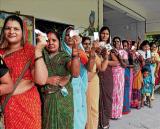 Raipur, Nov 11: Balloting picked up as the day progressed in the first phase of the Chhattisgarh assembly elections Monday while a trooper was injured in a huge blast in Kanker and a candidate was left bloodied in a clash between Congress and BJP workers. Maoists disrupted voting in forest areas at nine polling booths in Bijapur, Sukma, Konta and Antagarh assembly constituencies.
Raipur, Nov 11: Balloting picked up as the day progressed in the first phase of the Chhattisgarh assembly elections Monday while a trooper was injured in a huge blast in Kanker and a candidate was left bloodied in a clash between Congress and BJP workers. Maoists disrupted voting in forest areas at nine polling booths in Bijapur, Sukma, Konta and Antagarh assembly constituencies.
A Border Security Force (BSF) trooper was injured in a bomb blast in Kanker district while a bomb weighing about 10 kg was recovered in Bijapur, police said.
Congress and Bharatiya Janata Party (BJP) workers clashed in Jagdalpur and Konta assembly constituencies. Congress candidate from Jagdalpur Samu Kashyap was injured in the clash and was taken to hospital.
Polling for 18 assembly seats in Chhattisgarh's Maoist strongholds, which began early Monday on a dull note as several polling booths in the forested interiors were deserted, began to pick up pace as the day progressed.
There was tight security for the first phase polling for 12 seats in Bastar division and six seats in Rajnandgaon district in which a little over 29 lakh voters will exercise their franchise.
The `None of The Above' (NOTA) option, widely called `Right to Reject', is also making its debut in India in the Chhattisgarh polls.
Voting began for 13 seats at 7 a.m. sharp while it started at 8 a.m. for the remaining 5 seats. The majority of polling booths in the forested areas of Bastar wore a deserted look in the early hours.
Voting in constituencies where polling began at 7 a.m. will end at 3 p.m. so that polling officials can return safely from Maoist areas by sunset.
In urban areas such as Jagdalpur town, Kanker and in Rajnandgaon city, polling began at a brisk pace and long queues were seen at several booths.
In Rajnandgaon, where BJP candidate and Chief Minister Raman Singh is contesting, women and youth could be seen queuing up at polling booths.






Comments
Add new comment